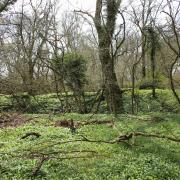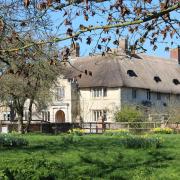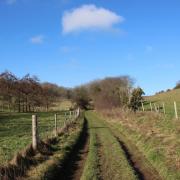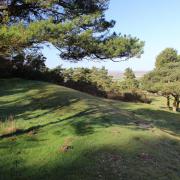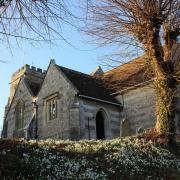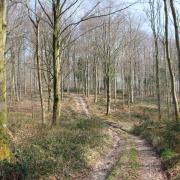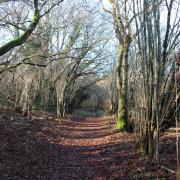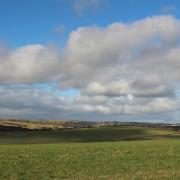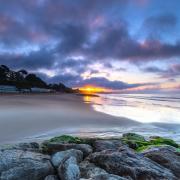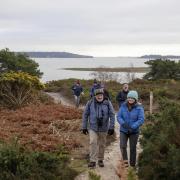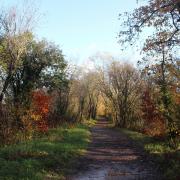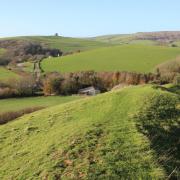Stroll through 4,000 years of Dorset’s history from the Bronze Age barrows of the Five Marys, overlooking the village of Chaldon Herring, to a 1950s nuclear research establishment on the edge of a wild heathland nature reserve that inspired Thomas Hardy's Edgon Heath on this walk with Edward Griffiths
This brief circuit of a peaceful corner of Dorset around Winfrith Newburgh embraces a span of 4,000 years between Bronze Age settlement and the development of nuclear power on the edge of a wild windswept heath that inspired writer Thomas Hardy’s Egdon Heath.
After leaving St Christopher’s Church in Winfrith Newburgh at the start of the walk and crossing the A352, there are glimpses across Winfrith Heath of the Winfrith Atomic Energy Establishment (AEE Winfrith). Its construction began in 1957, with the first low-energy reactor in operation by the end of 1959. The purpose of AEE Winfrith was to design and construct various nuclear reactors for research and assessment. By the 1960s, several experimental models were producing electricity including the most successful 1963 Steam Generating Heavy Water Reactor which, until it was shut down in 1990, supplied the National Grid. Other low-power generators were closed down when no longer commercially viable, whilst other models were developed purely for research into design, safety and performance. By 1990, AEE Winfrith had served its purpose and its closure by the Nuclear Decommissioning Authority began. All reactors had been removed by 2007 and, by 2023, Winfrith will be the first major nuclear site in the UK to be fully decommissioned and completely clean.

Neighbouring Winfrith Heath was designated a National Nature Reserve in 1985, and 250 acres were sold to Dorset Wildlife Trust in 2000. Here you will find the Blacknoll group of five Bronze Age bowl barrows with the largest, 63ft diameter, on a knoll with the 62m OS trig point. From here, easy walking along open heath lanes leads through Tadnoll before heading south to re-cross the A352 and ascend the shallow ridge and the Five Marys group of barrows.
Why Five Marys? Taylor’s 1765 Map of Dorset shows six barrows labelled ‘Five Meers’ meaning parish boundary markers. The barrows were used as convenient markers between Chaldon Herring (aka East Chaldon) and Owermoigne parishes. Parish bounds have changed since then and Owermoigne’s border is now further north, so the barrows no longer stand on the boundary. There are six barrows, so it’s not clear why they are known as the ‘Five Marys’, but the Mary part is a variation on the unfamiliar word ‘Meers’. When two of them were excavated, sometime before 1866, each contained a male burial with the occupant lying in a ‘sitting’ position, knees drawn up, with stag antlers positioned on each shoulder; one also held a female similarly bedecked with antlers.

The Five Marys overlook Chaldon Herring to the south where the old Sailor’s Return inn stands opposite the site of a small early 19th-century cottage known as ‘Miss Green’ by its former residents, writers and poets Sylvia Townsend Warner and Valentine Ackland. Sylvia had published her first poetry collection Espalier and her first two novels Lolly Willowes and Mr Fortune’s Maggot by the time she was 34. This was in 1927, the year she met Valentine Ackland who was visiting Dorset writer Theodore Powys at ‘Beth Car’, his house close by St Nicholas’ Church in Chaldon Herring. The two women moved into ‘Miss Green’ in 1930 and Sylvia wrote in her diary, they would ‘dawdle up the drove and sit on a Mary, listening to the wind in the grasses and admiring our small undesirable property from above’. In September 1937, they moved to Frome Vauchurch near Maiden Newton. Sadly, ‘Miss Green’ was destroyed by a German bomber jettisoning its load in 1940.

The Walk
1 The walk begins opposite Winfrith Manor House, built in the late-16th century with brick and coursed rubble-stone with stone-slate and clay-tiled roof. Off the ‘East Chaldon’ road, go through the ‘Village Centre Riverside Walk’ half-gate and follow the fenced path with left field and right ditch and gardens. At the fork, continue left on the footpath to a half-gate onto a T-junction. Go right on the lane for ‘Winfrith Heath’. At the right bend, take the left ‘Winfrith Heath’ footpath past the cottage’s end to the footpath-gate. Into the field, turn right along the hedge/fence then through another footpath-gate into the next field. Cross the field, ¼-left to the track left of the leftmost thatched cottage.

2 Cross the A352 onto the unsigned bridleway-track. In ½ mile, past right and left gates, go through the half-gate/gap into the field corner with a right gate. Continue along the right hedge to Dorset Wildlife Trust Nature Reserve 1½ gates. Through, follow the green path with left fields and right heath with Blacknoll barrows and glimpse of Atomic Energy Establishment buildings. Then, continue under trees to a left wooden fence where turn right at a bridleway-arrow post onto Winfrith Heath itself. Follow the clear hoof-print marked path north-east, passing another bridleway-post and another before meeting the road.

3 Turn left with heath both sides and further glimpses right of Atomic Energy Establishment buildings. Through cattle-grid/gates, continue to left Nutley Farm Campsite, past fields and River Frome tributary bridge at Tadnoll T-junction.

Turn left and follow the pleasant country lane for 1½ miles, passing Tadnoll Mill Farm and cottages, to the A352 again. Cross into the ‘East Chaldon 1’ lane. Walk to and ascend the ridge where bend left down to the left-fork grass track with ‘Five Marys ¼, Winfrith 1¼’ milestone.


4 Through 1½ bridleway-gates, walk past the Marys and share the views that Sylvia and Valentine enjoyed, except they never saw the Atomic Energy additions! Meander to another 1½ bridleway-gates and follow the track slowly down to a tracks’ junction with Fives Farm right.

Left goes to Wynards Farm. Continue straight down under trees to the East Chaldon road with backward bridleway-sign and Willowborne Gardens opposite. Turn left along the lane back to St Christopher’s car park where you started.

Compass Points
Distance: 5 miles/8kms
Time: 3½ hours
Exertion: Easy. One short gentle ascent
Start: St Christopher’s Church car park, Winfrith Newburgh (Grid Ref: SY805843)
Map: OS Landranger Sheet 194
Public Transport: CoastlinX54, Damory 30 and Morebus 31
Dogs: On leads in country lanes, and at Winfrith Heath Nature Reserve (ground nesting birds between April and August), abide by The Countryside Code
Refreshments: The Red Lion Hotel, Winfrith Newburgh, on the A352, for home-cooked food and award-winning ales





